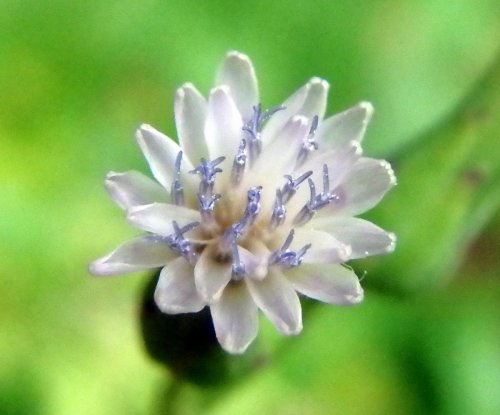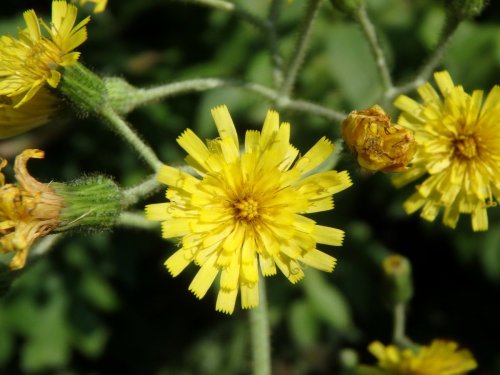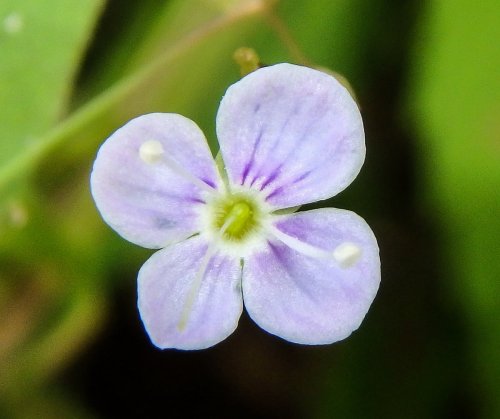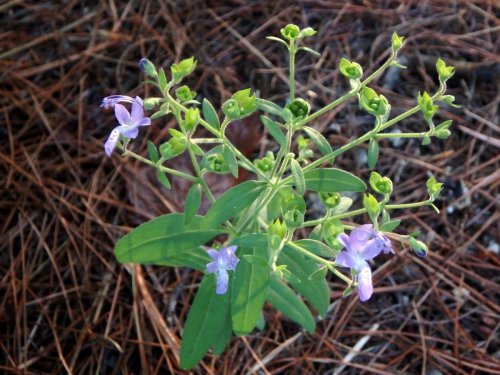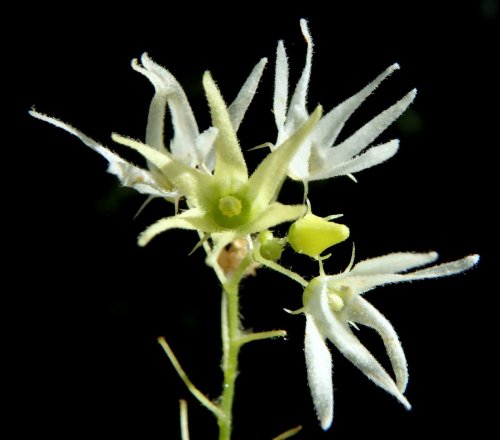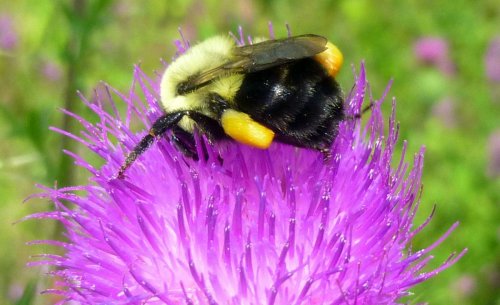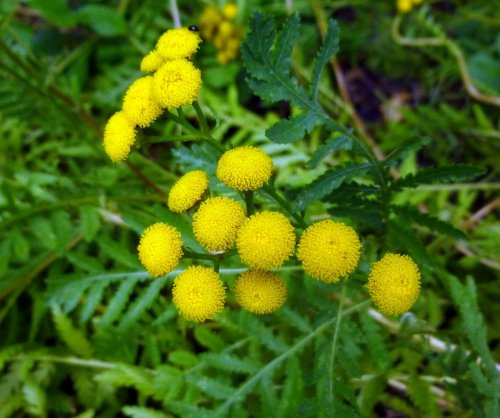It’s aster time here in New Hampshire and the will appear in all sizes and colors from now until a freeze. What I believe is crooked stemmed aster (Symphyotrichum prenanthoides) has just started blooming. This native aster gets its common name from the way the stems zig zag between the leaves. The stems are smooth and the leaves clasp it. The flowers are about an inch across and are usually pale lavender but this one was in the shade when I took its photo and that made it appear darker. This plant was about three feet tall.
Whorled wood aster (Oclemena acuminata) gets its common name from the way its leaves appear to grow in whorls around the stem from above. In botany, a whorl is an arrangement of at least three sepals, petals, leaves, stipules or branches that radiate from a single point around the stem, and the leaves of this aster really don’t fit the definition. Looking at them from the side the tiers of whorled leaves would appear flat like a plate, but these leaves appear randomly scattered up and down the stem’s length. The plant is also called sharp leaved aster and grows to about a foot and a half tall. It’s one of the easiest asters to identify because of its early bloom time and because the narrow white ray florets look like they were glued on by chubby fingered toddlers. The plant can take quite a lot of shade and I usually find it growing alongside the edges of woodland paths. I love the beauty of asters but I don’t like their message of summer’s passing, so when I stop and admire them I always feel a bit of wistfulness and wonderment that a season could pass so quickly.
Looking at them from the side the tiers of whorled leaves would appear flat like a plate, but these leaves appear randomly scattered up and down the stem’s length. Indian cucumbers have tiers of whorled leaves as do some loosestrifes. The plant is also called sharp leaved aster and grows to about a foot and a half tall.
I often find purple stemmed beggar’s ticks (Bidens connata) growing in the wet soil at the edges of ponds and rivers. This example was growing at the edge of a pond.
Purple stemmed beggar’s ticks have curious little yellow orange ray-less disc flowers that never seem to fully open and dark, purple-black stems. It is closely related to bur marigold (Bidens tripartita), and is also called water hemp because of the leaf shape. The name beggar’s tick comes from its barbed seeds that stick to fur and clothing like ticks. It is an annual that grows new from seed each year so there’s no telling where it might turn up.
I was surprised to find showy tick trefoil (Desmodium canadense) still blooming. This plant is a legume in the bean family and it gets part of its common name from the little barbed hairs that cover the seed pods and make them stick to clothing like ticks. The “showy” part of its common name comes from the way that so many of its small pink flowers bloom at once. As the plant sets seeds its erect stems bend lower to the ground so the barbed seed pods can catch in the fur of passing animals.
The flowers of tall blue lettuce have just about finished for this year. They can be white, deep blue, or ice blue. The deep blue ones are always the hardest to find but also the most beautiful and worth the effort. I haven’t seen a single one this year though. This one had hardly any blue at all until I looked closer.
If it was early June I wouldn’t have been surprised to find the maiden pink (Dianthus deltoids) in the above photo at the edge of a meadow, but it’s almost September. They must be having a good year. These flowers look like their cousins the Deptford pink (Dianthus armeria,) but that flower doesn’t have the jagged red ring around its center like this one does and it blooms later, usually in July. Maiden pinks are originally from Europe and have escaped cultivation but aren’t terribly invasive. They seem to prefer the edges of open lawns and meadows. Their colors can vary from almost white to deep magenta.
Native wild cucumber (Echinocystis lobata) is a late summer blooming vine that climbs on shrubs and trees like it’s doing in this photo. It likes to grow in sandy soil and prefers shade over full sun. The flower spikes (Racemes) grow to 6 inches or more all along the main stem. These plants are annuals and grow from seed each year.
The greenish white, star shaped male flowers of wild cucumber have 6 petals that are twisted slightly. The female flowers are yellowish green and not at all showy. They grow at the base of the male flower stems. There is usually only one female flower for every 5 or 6 male flowers, which is why there are so few fruits seen on each vine.
Wild cucumber climbs by the use of tendrils and, as Mike Powell noted on his blog recently, they look like the coiled stretchy cords that we used to see on phones. (If you can remember that far back.) If you aren’t reading Mike’s blog and you’re a nature lover, you’re doing yourself a disservice. You can find it over in the favorite links section on the right.
The spiny, 2 inch long fruits of wild cucumber have a watermelon shape and boys have been throwing them at each other for as long as I’ve been around. They look prickly but the spines are soft until the fruits dry out and drop their seeds. By then they’re so light and desiccated that they can’t be thrown at anybody. The fruit is not edible and doesn’t really resemble a cucumber.
Pretty groundnut (Apias americana) flowers are still blooming. They come in pink, purple or reddish brown and always remind me of the helmets worn by Spanish conquistadors. The plant is a vine that will climb just about anything and I usually find it growing in the lower branches of trees and shrubs along the river. Native Americans used the roots of the plant in the same ways we use potatoes today, but groundnut “potatoes” contain about three times the protein. Natives taught the early colonials how to use the groundnut and the plant helped save the lives of the Pilgrims during their first few years as settlers. Not surprisingly another name for it is Indian potato.
Field milkwort (Polygala sanguinea) doesn’t seem to be having a good year. I found a single plant with a single flower, and this is it. Or maybe I was just late; this flower head was showing yellow, which is something I haven’t seen. What look like petals arranged on a central stem are actually individual flowers packed into a raceme no bigger than the end of an average index finger. Each tiny overlapping flower has two large sepals, three small sepals, and three small petals that form a narrow tube. Several different kinds of bees help pollinate this plant. Its flowers can be white, purple, pink, or green. I know of only one place where it grows and its beautiful flowers always make it worth the walk to see them. The flowers are very beautiful and unusual enough to make you want to sit beside them for a while and study them, and quite often that’s just what I do.
Slender gerardia (Agalinis tenuifoliais) is also called false foxglove. There might be a faint resemblance but I think it would be hard to confuse the two, especially after a good look at the slender, sword shaped leaves. The blossoms are very hairy and have a long curved protruding pistil and especially from the side look nothing like foxglove to me.
Slender gerardia is a shy little plant that grows in the tall grass at the edge of meadows and I usually find it growing in full sun. It has the unusual habit of dropping all of its opened flowers each afternoon. It opens fresh buds at the start of each day which means that its flowers don’t even last for a full day, so insects (and photographers) have to be quick. The plants that I find are always 6-8 inches tall but I’ve read that they can reach 2 feet.
Native common yellow wood sorrel (Oxalis stricta) is unusual because it grows in woods or meadows and I see it in both. It’s considered a weed by many and is largely ignored by most, but it’s a very interesting plant. Its raw leaves can be chewed as a thirst quencher if you forgot to bring water on your hike. The Native American Kiowa tribe called it “salt weed” and used it that way for long walks. Its seed capsules can also be chewed but they can also explode when mature and can fling seeds up to 13 feet away. They are said to be tart with a flavor similar to rhubarb. The plant is high in vitamin C and it can be pressed to make a passable vinegar substitute.
When you’re trying to identify plants there are enough hawkweeds to make you crazy. While many have thin, wiry, leafless stems this one has thick, stout, one and a half foot tall stems with tough leaves most of the way up it. For those reasons I think it might be Gronovi’s hawkweed, which is also called queendevil (Hieracium gronovii.) I’m guessing that ranchers and pasture owners gave it that name, even though it’s a native plant.
Hawkweeds are slippery and hard to pin down, but I can’t find a reference to another hawkweed with leaves like this one except maybe rough hawkweed (H. scabrum.) The leaves actually make it look like it’s in the lettuce family, but the flowers are what you’d expect on a hawkweed and not the tiny flowers found on the various lettuce species. I find this one along trails right at the edge of the forest.
Since I started with an aster I might as well end with one. I think this one might possibly be a smooth blue aster (Symphyotrichum prenanthoides.) It grew along the shore of a pond and stood about knee high.
There are other asters this could be but knowing its name isn’t that important to me. More often than not just being able to see such a pretty thing is enough for me these days.
He who does not become familiar with nature through love will never know her. ~Friedrich Von Schlegel
Thanks for coming by.






